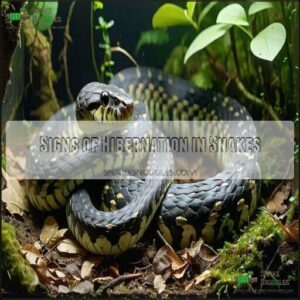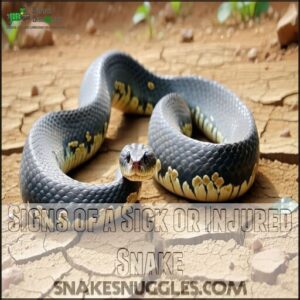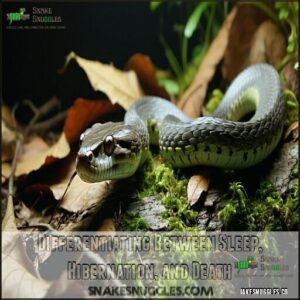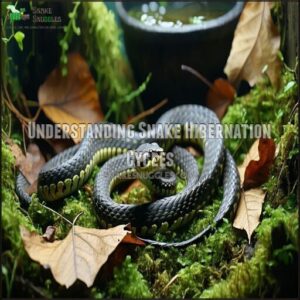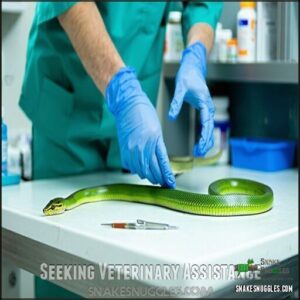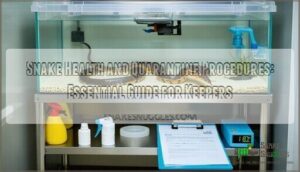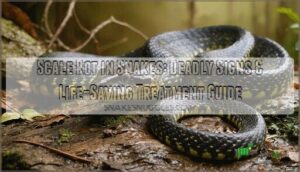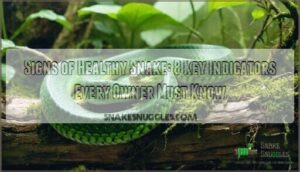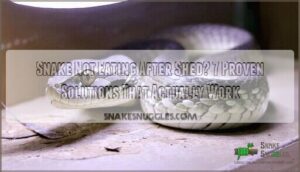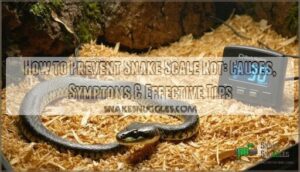This site is supported by our readers. We may earn a commission, at no cost to you, if you purchase through links.
 Figuring out if your snake is dead or hibernating comes down to a few key checks.
Figuring out if your snake is dead or hibernating comes down to a few key checks.
First, look for any small movements—hibernating snakes may still twitch or breathe very slowly.
Gently touch its body to feel for muscle tension; a stiff snake could be dead, while a hibernating one might feel limp.
Check for shallow breathing by observing its sides for movement.
Cooler temperatures could mean it’s hibernating, especially if it’s in a dormant posture.
If there’s no pulse, smell, or sign of life, it could be dead.
When in doubt, consult a vet—it’s better to play it safe than sorry, and this precaution can help determine if the snake is truly dead or just hibernating.
Table Of Contents
- Key Takeaways
- Is My Snake Dead or Hibernating?
- Signs of Hibernation in Snakes
- Signs of a Healthy Snake
- Signs of a Sick or Injured Snake
- Identifying a Dead Snake
- Differentiating Between Sleep, Hibernation, and Death
- Understanding Snake Hibernation Cycles
- How to Check for Breathing and Heartbeat in Snakes
- Seeking Veterinary Assistance
- Frequently Asked Questions (FAQs)
- Will a hibernating snake react if you touch a dead snake?
- Is your pet snake hibernating or dead?
- How do you know if a snake is dead or hibernating?
- How long does a snake hibernate?
- Do dying snakes lay on their backs?
- What if a pet snake is unresponsive or dead?
- What is the Difference Between a Hibernating and a Brumating Snake?
- How Can I Tell the Age of a Snake?
- How Can I Tell if My Snake is Sick?
- Is It Safe to Check a Dead Snake?
- Conclusion
Key Takeaways
- Gently touch your snake to feel for muscle tension—dead snakes are stiff, while hibernating ones are limp.
- Look for subtle signs of life like slow breathing, tongue flicking, or slight movement when handled.
- Check the body’s temperature—hibernating snakes may feel cool, but dead snakes are completely cold.
- Contact a vet if you’re unsure, as they can confirm whether your snake is hibernating or dead.
Is My Snake Dead or Hibernating?
Finding your snake motionless can trigger immediate concern. Is it dead or hibernating? During winter, snakes enter brumation, becoming extremely inactive.
During winter, snakes enter brumation—a natural energy-saving mode where they become extremely inactive and conserve vital resources.
A hibernating snake feels cool but shows subtle signs of life—occasional slight movement and mild reaction when handled.
Dead snakes display clear signs: complete unresponsiveness during an unresponsive snake test, rigor mortis, and zero muscle tone. Their open eyes appear cloudy or sunken, unlike a living snake’s clear eyes.
Remember when checking snake health: even dead venomous snakes may retain reflexes for hours, so practice safe cold snake handling techniques with all unmoving snakes.
Signs of Hibernation in Snakes
You’ll notice several key behaviors when your snake enters hibernation, also called brumation.
Your snake will become less active with slower movements and will seek cooler spots in its enclosure while its body functions slow down to conserve energy.
Reduced Activity and Movement
When your snake barely moves for days, you’re witnessing brumation—nature’s energy-saving mode for reptiles.
During hibernation, your snake’s activity levels drop dramatically as it responds to cooler temperatures. This sluggish behavior is completely normal during winter months.
Snakes slow their metabolism, entering a state of brumation to conserve energy.
Watch for these movement patterns:
- Your snake remains coiled in one spot for extended periods
- Tongue flicking becomes infrequent or stops entirely
- Responses to touch are delayed but still present
- Body adjustments happen slowly and deliberately
Snake inactivity during brumation isn’t a sign of illness but a natural survival strategy. Your normally active pet appears lazy because its body is conserving energy.
Reduced reflexes and minimal movement are normal hibernation signs, not health concerns. However, if your snake shows no reaction when gently touched, this lack of response might indicate problems beyond normal dormancy.
Activity triggers like warming temperatures should eventually restore normal behavior, making it essential to monitor your snake’s response to touch and overall activity level to ensure it’s just experiencing normal dormancy.
Lowered Metabolic Rate
During brumation, your snake’s metabolic rate drops substantially as part of energy conservation. This natural slowdown affects every cellular activity in your pet’s body.
The following table illustrates the physiological changes that occur during brumation:
| Physiological Change | Normal State | Brumation State |
|---|---|---|
| Heart Rate | 30-40 beats/minute | 5-10 beats/minute |
| Breathing | Every few seconds | Once per 4-5 minutes |
| Digestion | Active | Completely paused |
| Energy Use | Normal | Minimal |
| Organ Function | Full capacity | Maintenance mode |
You’ll notice your snake won’t eat during this time. This digestion slowdown is normal – their bodies can’t process food efficiently at lower temperatures.
Snake dormancy is actually a survival mechanism. Think of it as your pet switching to "battery saving mode." Their temperature dependence means all bodily functions slow down to conserve resources. This snake inactivity isn’t cause for alarm – it’s simply how they naturally survive periods of cold.
Seeking Cooler Areas
The instinct for survival drives your snake’s behavior as hibernation approaches.
During seasonal changes, you’ll notice your pet actively seeking cooler areas in their enclosure – a natural sign of approaching brumation.
When temperatures drop below 60°F, watch for these snake hibernation signals:
- Your snake abandons warm basking spots for cooler, shadier corners
- It consistently chooses the coolest hide despite having warm options available
- Movement becomes purposeful rather than random, showing natural instincts
- When touched, it responds slowly but deliberately, unlike a sick or dead snake
This temperature gradient seeking is perfectly normal brumation behavior. Your snake is following ancient instincts, preparing its body for dormancy during winter months.
The enclosure cooling they seek helps slow their metabolism safely, allowing them to conserve energy until warmer days return, which is a result of their ancient instincts and a sign of normal behavior.
Signs of a Healthy Snake
Now that you understand hibernation patterns, let’s look at how to spot a truly healthy snake.
A healthy snake shows clear signs of liveliness in its daily behavior. You’ll notice:
- Active Behavior: Your snake will move smoothly around its enclosure and flick its tongue regularly to explore
- Clear Eyes: Bright, alert eyes without any cloudiness or discharge
- Regular Shedding: Complete sheds in one piece rather than patchy sections
- Healthy Weight: A well-proportioned body where you can’t see the spine protruding
When handled, a healthy snake responds to touch and maintains good muscle tone. They’ll show interest in their surroundings rather than remaining limp or unresponsive.
Look for glossy scales that shine in the light – dullness often signals health problems, especially in baby corn snakes where shiny scales are a key indicator of good snake health.
Signs of a Sick or Injured Snake
You’ll need to recognize key warning signs that separate a sick snake from one that’s simply hibernating.
Unlike hibernating snakes that respond slowly to touch, sick snakes often show specific symptoms like unusual postures, skin problems, or complete lack of response when handled, including unusual postures and skin problems.
Sick snakes show unusual postures, skin issues, or complete lack of response—key signs to distinguish illness from brumation.
Lack of Appetite
A significant warning sign of illness in your pet snake is a notable change in eating habits. While healthy snakes maintain regular feeding schedules, sick ones often refuse food for extended periods.
Watch for these concerning appetite changes:
- Complete food rejection lasting more than two weeks (when not hibernating)
- Visible weight loss with muscle wasting along the spine
- Regurgitation of prey after successful feeding attempts
Different species have varying normal feeding schedules. Ball pythons might skip meals occasionally, while corn snakes rarely refuse food when healthy. Understanding the proper feeding schedule is essential for snake owners.
If your snake hasn’t eaten for three weeks outside snake brumation periods, it’s time for a vet visit. Solutions include offering smaller prey, trying different food types, or adjusting feeding temperature. Never force-feed without professional guidance.
Prevention starts with proper habitat temperatures and humidity levels. Track feedings to identify patterns and detect appetite changes early before they become serious health concerns.
Unusual Posture or Behavior
Five key signs can reveal your snake’s health through its posture and movements.
During illness, snakes often display unnatural coiling or stargazing behavior where they stare upward for extended periods.
Watch for head tilting, open mouth breathing (indicating respiratory infections), or erratic movements when handled.
Healthy snakes move fluidly, while sick ones may freeze in awkward positions or lie completely limp.
Unlike snake brumation, where slow movement is normal, a sick snake shows no muscle tone when lifted.
If your pet remains motionless for hours or doesn’t respond to gentle touch, it’s not hibernation or dormancy—contact a veterinarian immediately.
Unusual posturing can also indicate potential neurological issues.
Skin Abnormalities
Skin issues can reveal a lot about your snake’s health. These aren’t tied to snake hibernation but often point to illness or injury.
Watch for:
- Scale Rot or Blister Disease: These appear as red or dark markings, especially on belly scales, and can worsen without treatment.
- Dysecdysis (Abnormal Shedding): If your snake’s skin doesn’t shed in one piece, it may signal dehydration or low humidity.
- Mite Infestation or Scarring: Look for small, moving dots or damaged scales caused by parasites.
Discolored skin or cloudy eyes (outside normal shedding) are warning signs. If you notice these, don’t delay—visit a vet.
They’re critical signs, not dead snake signs or sleep-related issues. Addressing snake scale rot early is essential for recovery.
Identifying a Dead Snake
If your snake isn’t moving, it’s time to spot the unmistakable signs of a dead snake.
These indicators can help you differentiate between snake hibernation vs death:
- Cold Body: A dead snake feels completely cold to the touch, unlike a hibernating one.
- Rigor Mortis: Within hours, muscles stiffen, and the body becomes inflexible.
- Unresponsiveness: There’s no reaction to handling or gentle prodding—your snake remains limp.
- Physical Changes: Look for cloudy, open eyes that lack shine, potential skin discoloration, and (later) foul odors.
When dead snake signs are present, consult a vet to confirm.
A proper check guarantees you’re not mistaking the natural stillness of hibernation for snake death.
Differentiating Between Sleep, Hibernation, and Death
It’s not always easy to tell if your snake is sleeping, hibernating, or has passed away. Understanding their behavior and physical signs can help you make the distinction.
Hibernation Vs. Sleep Patterns
Recognizing the differences between snake hibernation and snake sleeping patterns helps you spot concerns.
While sleeping, your snake’s metabolism remains normal, and it reacts speedily to touch. Sleep duration is brief, often in predictable cycles, with noticeable snake naps in familiar spots.
During hibernation (or dormancy), its metabolic processes slow markedly, body temperature drops, and reactions to touch become delayed. Unlike dreamy-looking nap poses, snakes in hibernation remain motionless, conserving energy.
Understanding their brumation characteristics is also very important. Monitoring these snake hibernation signs helps guarantee your pet stays healthy.
Identifying Death in Snakes
When figuring out if your snake is dead, focus on these three key indicators:
- Rigor Mortis: A dead snake’s body stiffens within hours, losing all flexibility.
- Eye Appearance: Look for cloudy or sunken eyes, which are common snake death signs.
- Body Temperature: A dead snake feels cold to the touch and doesn’t warm when handled.
Unlike a hibernating snake, a dead snake won’t respond, move, or breathe.
Try placing a mirror near its nostrils—no fog means no signs of life.
Stay observant during snake handling to confirm.
Understanding Snake Hibernation Cycles
When temperatures drop, snakes enter brumation, a state of dormancy for energy conservation.
Unlike mammal hibernation, brumation involves minimal movement and a metabolic slowdown, helping your snake survive cooler conditions.
You’ll notice slower activity and reduced appetite, but water consumption continues. A key aspect is body temperature regulation, which helps them conserve energy.
- Seeking cooler spots in the habitat.
- Movement becoming sluggish or deliberate.
- Food refusal as digestion slows down.
- Extended periods of resting.
Maintain habitat temperature carefully to prevent extreme cold and guarantee healthy snake dormancy during this natural survival process.
How to Check for Breathing and Heartbeat in Snakes
Wondering if your snake is alive? Start by checking for Visual Breathing Signs. Look closely for tiny movements in its sides or hold a mirror near its nostrils—fogging means breath.
To assess the heartbeat, gently press two fingers behind its head and feel for a faint, rhythmic pulse. Specialized tools, like a Doppler or stethoscope, amplify sounds for clearer results. A reptile stethoscope purchase can help with this process.
Here’s how you can check signs of life:
- Watch for tongue flicking.
- Feel for slight body warmth.
- Use listening devices like a stethoscope.
Take your time to ensure you are checking all the necessary signs to determine if your snake is alive, and remember to be gentle during the assessment process.
Seeking Veterinary Assistance
If you’re unsure whether your snake is dead or hibernating, contacting a veterinarian is the best way to get answers.
They can examine your pet and provide guidance to address any health concerns.
When to Seek Professional Advice
Regarding your snake’s health, knowing the right time to seek veterinary care is key. If you’re facing an uncertain diagnosis or observing prolonged symptoms like persistent lethargy, respiratory issues, or behavioral changes, it’s time to act.
Certain emergency signs—like difficulty breathing or extreme inactivity—require immediate attention from a snake veterinarian. In some cases, problems can be subtle, such as abnormal shedding or refusal to eat.
Don’t hesitate to schedule a snake veterinarian consultation if something feels off. Regular preventative care also helps catch issues early. Remember, snakes don’t always show clear signs of illness, so reliable snake veterinarian advice can save their life.
Veterinary assistance makes certain you’re not overlooking a serious problem. Always prioritize professional help.
Steps to Take if You Suspect Illness
If you’re asking, “Is my snake alive?” or noticing your snake not moving well, it’s time to act fast.
Here’s how you can respond:
- Isolate Snake: Move your snake to a clean, quiet enclosure. This reduces stress and keeps potential illness contained.
- Monitor Symptoms: Watch for snake illness signs like unusual behavior, lack of appetite, or difficulty shedding. Note everything, including hydration levels using skin elasticity tests.
- Temperature Regulation: Make certain the enclosure has proper heat. Low temperatures can worsen symptoms.
Check for signs of life—breathing, tongue flicking, or gentle responses. If you’re unsure, contact a veterinarian immediately.
Veterinary consultation is key, as many conditions can improve with swift care. Delays only increase risks for your pet.
Frequently Asked Questions (FAQs)
Will a hibernating snake react if you touch a dead snake?
It’s like tapping a statue versus a sleeping cat.
Hibernating snakes will often respond with slight movement or sluggish reactions to touch, while a dead snake remains completely limp, motionless, and unresponsive.
Is your pet snake hibernating or dead?
Check if your snake reacts to touch, warmth, or handling.
A hibernating snake may respond sluggishly, while a dead one feels cold, stiff, and unresponsive with no movement, breathing, or tongue flicking.
How do you know if a snake is dead or hibernating?
When in doubt, observe specifics: dead snakes are completely cold, limp, and unresponsive.
While hibernating ones might still react, feel warm, or show subtle signs of life like slow tongue flicking or sluggish movement.
How long does a snake hibernate?
A snake’s hibernation, or brumation, usually lasts several weeks to a few months, depending on the species and climate.
Cooler temperatures trigger this process, with some snakes staying dormant throughout the entire winter season.
Do dying snakes lay on their backs?
Dying snakes don’t typically lie on their backs.
If a snake is upside down and unresponsive, it’s a concern.
Healthy or hibernating snakes will usually correct themselves if placed on their back.
What if a pet snake is unresponsive or dead?
If your snake is unresponsive, check for breathing, tongue flicks, and stiff muscles.
A dead snake is cold, limp, or rigid with cloudy eyes.
Contact a vet if you’re unsure about its condition.
What is the Difference Between a Hibernating and a Brumating Snake?
Hibernation and brumation differ in activity levels.
Hibernating snakes are entirely still, conserving energy.
Brumating snakes remain sluggish but can react to touch or movement.
Both conserve energy in cooler temperatures but vary in responsiveness and energy conservation methods.
How Can I Tell the Age of a Snake?
You can estimate a snake’s age by its size, growth rings on its scales, and wear on its patterns.
Older snakes often have faded colors, less distinct markings, and may show growth scars over time.
How Can I Tell if My Snake is Sick?
About 75% of reptile illnesses show visible signs like weight loss, cloudy eyes, or odd behaviors.
Watch for discharge from the nose or mouth, labored breathing, unusual posture, or lack of appetite.
Consult a vet quickly.
Is It Safe to Check a Dead Snake?
It’s generally safe to check, but always handle with caution.
Use a stick or gloves to avoid direct contact, especially if decomposition has started or you’re unsure of the snake’s health or cause of death, and remember to always handle with caution.
Conclusion
Did you know that snakes can slow their metabolism by up to 70% during hibernation?
If you’re wondering, “is my snake dead or hibernating,” focus on checking for small signs like shallow breathing, muscle tension, or movement.
Remember, a stiff, unmoving snake may be dead, while a limp body suggests hibernation.
If you’re unsure, don’t hesitate to consult a vet.
Spotting the difference quickly guarantees proper care for your snake and peace of mind for you.
- https://onlinelibrary.wiley.com/doi/abs/10.1111/jpn.12040
- https://oddlycutepets.com/do-snakes-roll-over-when-they-die/
- https://www.news18.com/news/buzz/beware-a-snake-may-be-dangerous-for-hours-after-its-death-710928.html
- https://www.musconetcong.org/single-post/notes-from-a-musky-trail-hiker-9-do-snakes-get-rigor-mortis
- https://www.thesprucepets.com/signs-your-snake-is-sick-4173973

